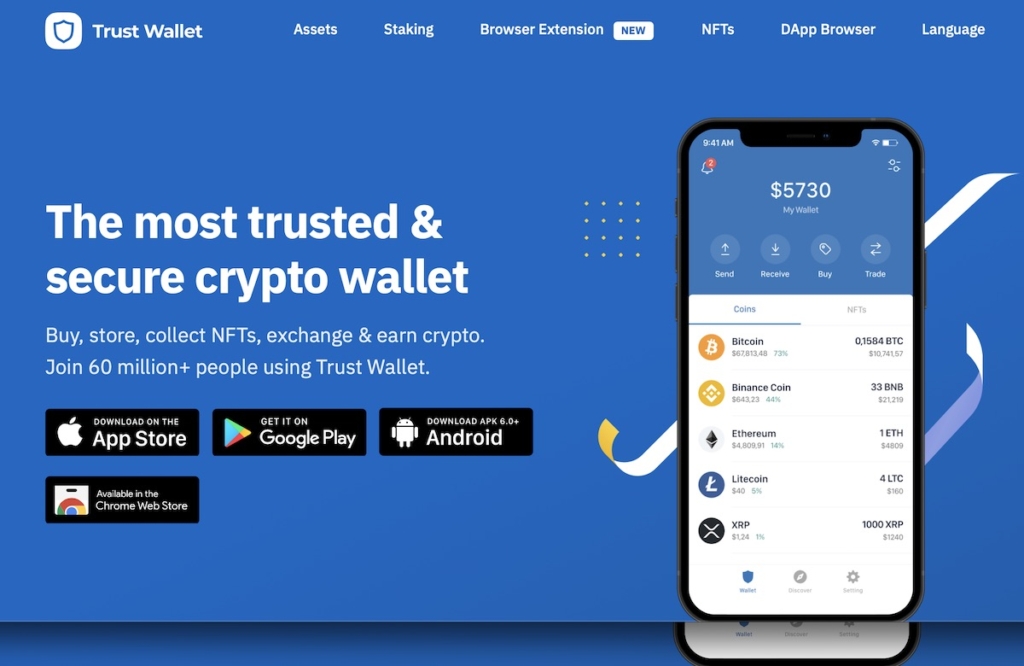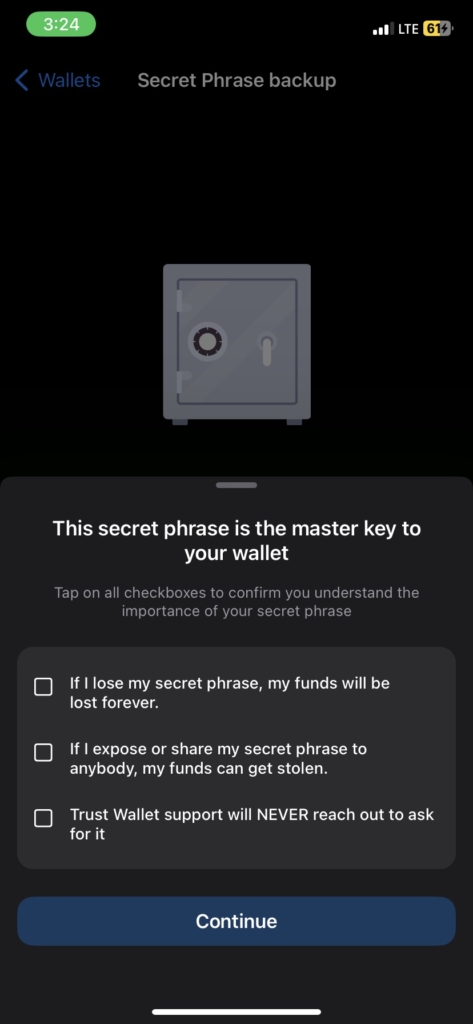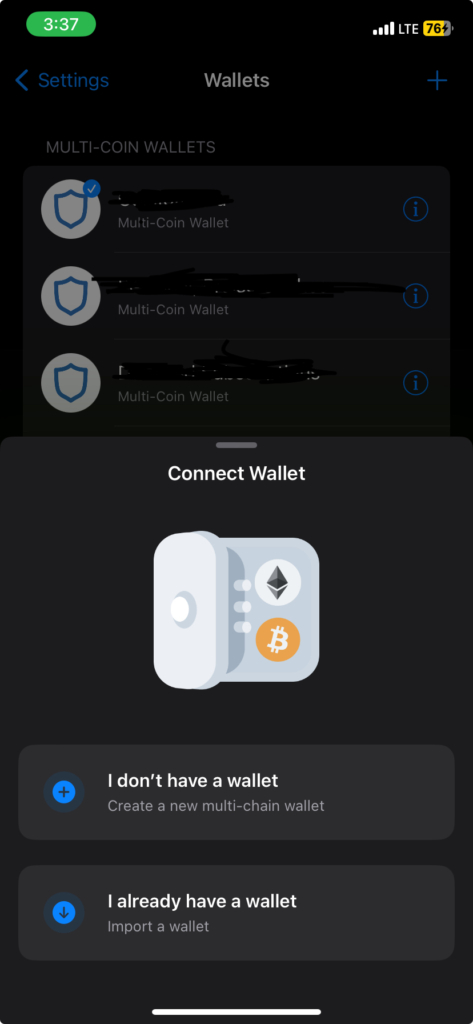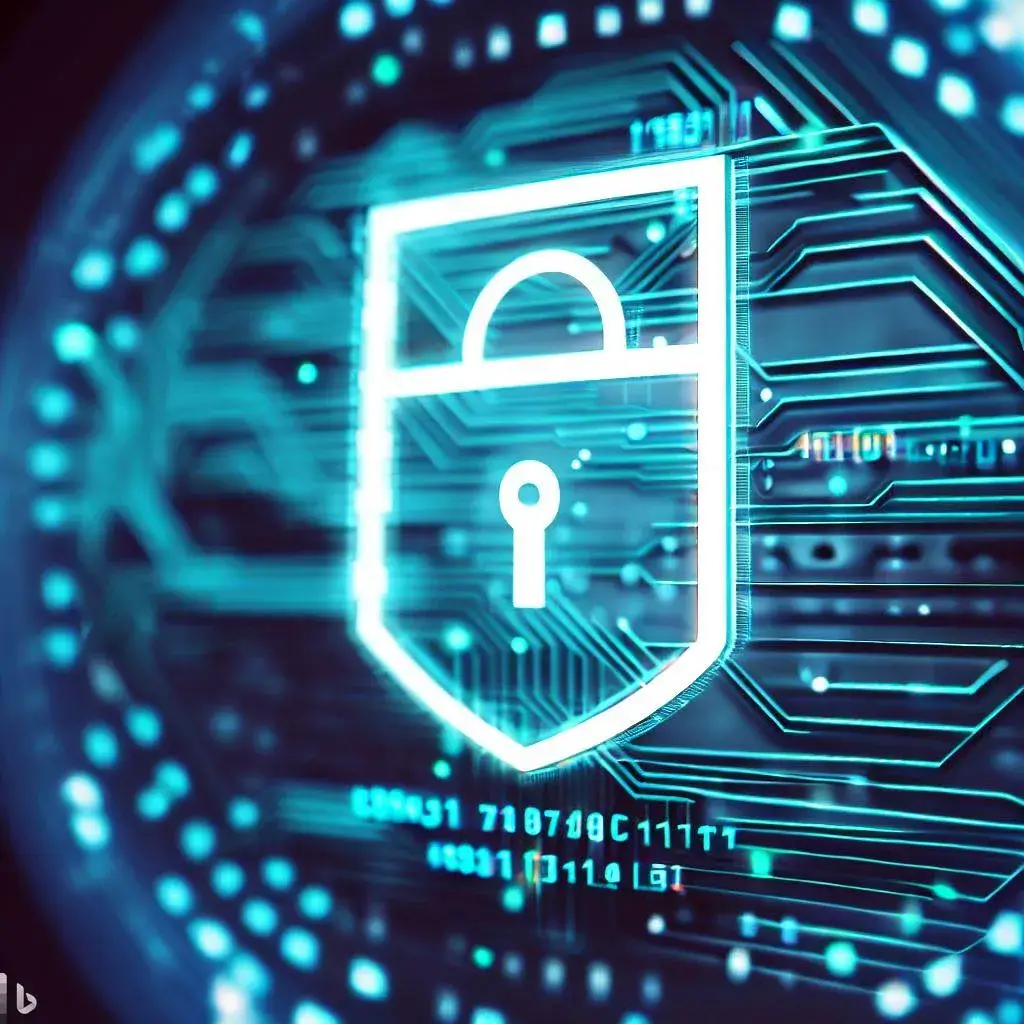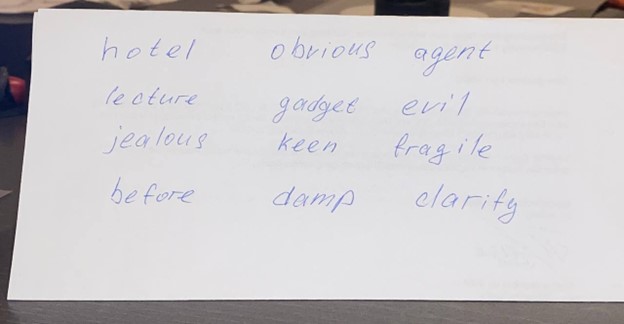Trust Wallet is one of the most popular cryptocurrency wallets in the industry, servicing over 60 million users across the globe. It is a free, non-custodial software wallet that allows users to send, receive, trade, purchase, and store digital assets, including non-fungible tokens (NFTs).
For beginners, Trust Wallet is the go-to crypto wallet in the DeFi world, as it offers an easy-to-use interface designed to get you started on your crypto trading and investing journey. In this comprehensive Trust Wallet guide, we will list some key features that set it apart from other non-custodial wallets and how to get started with the wallet right away.
Pros
- Easy-to-use interface
- Supports multiple digital assets and blockchains
- Non-custodial, can be integrated with HD wallets
- Access to DeFi and Web3 apps
Cons
- Non-custodial: Risk of phishing scams and zero-transfer attacks.
- No desktop app
- Limited customer support
What is Trust Wallet?
Trust Wallet is a non-custodial wallet, which means that it grants users complete control over their private keys. The wallet is committed to making crypto assets and DeFi more accessible to everyone; hence, it offers access to multiple blockchain networks and millions of digital assets.
Trust Wallet creates a bridge between the different blockchain networks and their respective nodes. Since it is non-custodial, the wallet does not hold users’ digital assets but allows them to access the blockchain networks where their assets are encrypted and secured.
The wallet was originally designed for mobile devices, with the mobile app available for Android and iOS devices. However, it recently added a browser extension allowing users to access the wallet via Chrome as a web wallet. This move is somewhat anticipated because Metamask, Trust’s biggest competitor, became very popular on its web interface.
Once installed, Trust Wallet allows users to buy, sell, swap, send, receive, and store thousands of crypto assets. It also grants users access to decentralized applications (dApps), including NFT marketplaces, Web3 gaming platforms, decentralized exchanges (DEXs), and staking platforms.
Who is Behind Trust Wallet?
Viktor Radchenko, a Ukrainian tech entrepreneur, founded Trust Wallet in 2017. The idea to develop Trust Wallet was borne out of Radchenko’s desire to manage all of the ERC-20 tokens he acquired from participating in different ICOs in 2017.
In November 2017, Radchenko launched the first version of the wallet, which immediately captured the attention of early crypto adopters thanks to a unique feature not offered by other crypto wallets at the time. Dubbed “automagically tokens,” this feature allowed users to find and reveal any ERC-20 tokens associated with their address.
By March 2018, Radchenko quit his full-time job to focus on working on Trust Wallet as the user base continued to expand. Along with a small team, Radchenko started adding new features to the wallet and responding to the increasing requests for customer support services.
On July 31, 2018, Binance – the biggest crypto exchange by trading volume – acquired Trust Wallet. Radchenko believed that the fast-rising crypto exchange would give Trust Wallet a runway to continue growing and improving the crypto ecosystem. With the acquisition, which was the very first for Binance, the exchange added a secure, on-chain mobile wallet to its growing list of services.
Fast forward to 2023, Trust Wallet has a user base of over 60 million people worldwide and has remained the official crypto wallet of Binance Exchange.
Trust Wallet Major Features
Trust Wallet offers Web3 users many great features that make it a favorite among millions of DeFi degens and crypto traders. Some of the key elements that the wallet provides include:
Free Crypto Wallet: Web and Mobile
Trust Wallet can be used for free. It does not require any subscription fee to download or use it to store crypto. It also does not charge any fees for in-app transactions or swaps. However, users need to pay the blockchain network fees used to process their transactions, which vary depending on the network congestion.
Multi-Coin Support
Only a few crypto wallets offer users a wide range of crypto assets Trust Wallet offers. The wallet’s robust mechanism allows it to connect to multiple blockchain networks, granting users access to millions of digital assets.
Trust Wallet supports over 65 blockchains and access to more than 4.5 million digital assets. Users can buy, exchange, and store these digital assets using the wallet.
Built-In Staking
Staking is one of the most popular ways to earn passive income in crypto. Staking means locking tokens into a smart contract in exchange for rewards (interest), which generates passive income.
Trust Wallet gives users access to a built-in staking feature that makes it quick and convenient to start staking without a need to connect to a third-party provider. The wallet supports staking on over ten popular staking coins, including BNB, ALGO, OSMO, and TRX.
Although Trust Wallet offers competitive staking rewards, it is important to note that the annual percentage yield (APY) depends on the selected coin and the broader market conditions. Thus, users must do their own research before staking via Trust Wallet and in general.
Built-In dApp Browser
The wallet offers seamless access to hundreds of dApps available in the market. The best part is that users do not have to sign in to these dApps; they can access them directly from the Trust Wallet interface.
The wallet allows users to access dApps such as DEXes, staking platforms, yield farming, dual investments, crypto lending dApps, and many more. Trust Wallet ensures that only the most trusted dApps are integrated into its system through a thorough vetting process.
Once users click the dApps button, Trust Wallet presents them with various applications to interact with, including PancakeSwap, Uniswap, Aave, 1inch, Curve, and OpenSea. Moreover, since Trust Wallet is predominantly mobile-based, these dApps are optimized for mobile to allow users to access them at all times from their devices.
In-App Swap
Trust Wallet allows users to quickly exchange one crypto asset for another on the same or different blockchain without accessing a DEX via the in-app browser. To use the Swap feature, users just have to choose the coins they want to swap and the desired amount.
Support for NFTs
Non-fungible tokens (NFTs) have become a staple in Web3 following their rise to fame in the past few years. These unique tokens are digital representations of real-world objects, including music, photos, art, and real estate.
Trust Wallet allows users to store and manage their valuable NFTs on the platform securely. The wallet also supports popular NFT marketplaces like OpenSea, where users can conveniently trade NFTs. Trust Wallet fully supports NFTs built on over nine blockchain networks, including Ethereum, BNB Chain, Solana, and Polygon.
Intuitive User Interface
Trust Wallet has one of the best user interface designs of a non-custodial wallet. Navigating the user interface is intuitive and easy to follow. It is beginner-friendly, making it easy for beginners to figure out how to use the wallet’s features.
Security Features
Trust Wallet places the safety and security of user funds and data at the core of its operations. Trust Wallet takes a proactive approach to security, offering users complete ownership of their wallets’ private keys.
Additionally, the wallet employs some of the best encryption systems available in the industry across all of its products. It also has an in-built Security Scanner that enables users to identify potential risks while conducting transactions within the wallet.
The Trust Wallet Token (TWT)
Trust Wallet had launched its native cryptocurrency, the Trust Wallet Token (TWT), a multi-purpose BNB Smart Chain (BEP20) token designed to offer unique utilities to users and drive engagement.
With a total supply of 1 billion, TWT can be used as a governance token, allowing users to influence decisions surrounding new blockchain integrations, token listings, and product features on Trust Wallet.
The token also serves as affiliate and bounty rewards for referral campaigns, quizzes, and user-assisted tips. Users can also earn TWT by performing tasks like staking and discounts on in-app purchases.
How to Install and Use Trust Wallet?
Trust Wallet is primarily a mobile-based crypto wallet. However, users can also use the Chrome browser extension for desktop. Here’s a step-by-step guide on how to install the Trust Wallet on mobile.
Step 1: Download Trust Wallet
To avoid falling victim to fraudulent sites, it is best to visit the official website of Trust Wallet and download the mobile app. Select your preferred device type (Android or iOS) and install the app.
Step 2: Create New Wallet
Once you have installed the Trust Wallet app, open it and click on the “Create a New Wallet” button to get started. Alternatively, you can click the “Import a Wallet” button if you want to restore your wallet by private key.
Step 3: Create a Passcode
Next, Trust Wallet will ask you to create a strong passcode to secure the wallet, depending on your device. Chrome extension users will have to create an 8-character password consisting of letters, numbers, and symbols. App users, however, will be required to set up a 6-digit passcode.
Step 4: Backup Your Seed Phrase (Important)
This is the most critical step to take when creating a Trust Wallet. First, check the three boxes regarding the backup to indicate agreement. The wallet will then display a 12-word secret recovery seed phrase, which will enable you to recover your account if you lose your device or want to move to a new device.
Important: Never save these words online or offline (on your PC), and never share them with anyone, as they grant full access to your wallet and funds. Write them down on a piece of paper, and ensure the words are in the correct order as displayed on your screen. Click here for more private key security tips.
Step 5: Confirm Your Seed Phrase
Next, Trust Wallet will ask you to re-enter and verify the 12-word recovery phrase that was displayed on the previous screen. Here, you need to tick the boxes containing each word in the correct order.
Step 6: Ready to Receive Crypto
Once you successfully confirm your backup phrase, the set-up process is complete, and you will be automatically logged into your Trust Wallet. Your wallet will be empty at this stage and now you can start receiving and sending crypto.
Step 7: Buy Crypto with a Credit Card on Trust Wallet
Trust Wallet lets you buy crypto with a debit or credit card in the wallet. Click on “Buy” and select the crypto asset you wish to purchase, set the amount, and the FIAT currency to pay with. Select a third-party payment provider and verify the fees. Once done, click “Confirm” to purchase and wait for the funds to be sent to your crypto wallet.
Alternatively, you can receive crypto assets from another wallet. Simply click on “Receive” and select the coin you wish to receive. Copy the wallet address provided and complete the transfer to that address from an external wallet.
Tip: It is always best to send a small amount, and wait for it to be received before sending the total amount.
Creating Multiple Wallets
Trust Wallet allows users to create or add multiple accounts, each with a unique recovery phrase. To add a new account, go to settings, select wallet, and click on the + icon at the top right corner. This will allow you to create a new wallet or import an existing one.
Security Best Practices for Using Trust Wallet
Trust Wallet is a non-custodial wallet, meaning users are responsible for securing their digital assets. The wallet has no access to user data; as such, it cannot help users retrieve their lost or stolen accounts.
Nonetheless, here are a few helpful tips that can help you safeguard your assets while using Trust Wallet. For more wallet security tips – please visit our dedicated guide.
Never Share Your Seed Phrase
Anyone with the seed phrase controls the funds in the account. Hence, it is important to safeguard your backup phrase and back it up properly. Never save the phrase online (or on any device connected to the internet) since hackers might hijack your device and easily get access to your wallet.
Avoid Clicking on Any Random Links
With cryptocurrencies becoming more popular, hackers are developing sophisticated methods to steal these digital assets, including malicious links in emails and text messages. Do not click on random links to avoid falling victim to these hacking attempts, even if you know the sender.
Only Use Official Trust Wallet Channels and Website
A well-known method the bad actors use is pretending to be Trust Wallet support agents to trick users into revealing their private keys.
Remember, Trust Wallet (or any other wallet) will never reach out to you for any giveaways, airdrops, or request your seed phrase for any reason. Do not share information about your wallet on public channels like Telegram, as scammers can easily exploit you under the guise of offering assistance.
Use a Hardware Wallet
For better security of more significant amounts, use a hardware wallet to integrate it into your non-custodial wallet. Since web wallets are often prone to hacking attacks, storing large amounts of crypto assets offline using hardware wallets is often best.
Trust Wallet recently added support for Ledger, one of the most popular hardware wallets available in the market.
Conclusion
Trust Wallet caters to the needs of its millions of users due to its simple but intuitive user interface. While the wallet’s interface is beginner-friendly, it also features advanced functionalities for expert traders and users.
By providing users with a single interface that facilitates trading and storing millions of digital assets and access to DeFi applications, NFT marketplaces, and staking platforms, Trust Wallet markets itself as an all-in-one solution for all crypto-related transactions.
Trust Wallet makes up for what it lacks in 24/7 customer support service with its community help center that provides different self-help guides on how to use the platform. Users can also chat with Trust Wallet’s GPT-powered assistant for general information on how to use the wallet.
Lastly, Trust Wallet’s affiliation with Binance, the world’s largest crypto exchange, makes it even more appealing to users.

